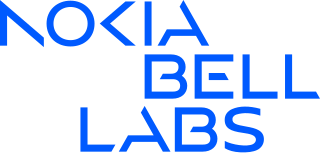
Nokia Bell Labs, originally named Bell Telephone Laboratories (1925–1984), then AT&T Bell Laboratories (1984–1996) and Bell Labs Innovations (1996–2007), is an American industrial research and scientific development company owned by Finnish company Nokia. It is headquartered in Murray Hill, New Jersey, and operates a global network of laboratories.
Lucent Technologies, Inc. was an American multinational telecommunications equipment company headquartered in Murray Hill, New Jersey. It was established on September 30, 1996, through the divestiture of the former AT&T Technologies business unit of AT&T Corporation, which included Western Electric and Bell Labs.

The 5ESS Switching System is a Class 5 telephone electronic switching system developed by Western Electric for the American Telephone and Telegraph Company (AT&T) and the Bell System in the United States. It came into service in 1982 and the last unit was produced in 2003.
The Western Electric Company was an American electrical engineering and manufacturing company officially founded in 1869. A subsidiary of the American Telephone and Telegraph Company for most of its lifespan, it served as the primary equipment manufacturer, supplier, and purchasing agent for the Bell System from 1881 until 1984, when the system was dismantled. The company was responsible for many technological innovations, as well as developments in industrial management.

The Trimline telephone is a series of telephones that was produced by Western Electric, the manufacturing unit of the Bell System. These telephones were first introduced in 1965 and are formally referred to as the No. 220 Hand Telephone Sets. The Trimline was designed by Henry Dreyfuss Associates under the project direction of Donald Genaro; the firm had produced the previous post-war desktop telephone types for the American Telephone & Telegraph Company.

NEC Corporation is a Japanese multinational information technology and electronics corporation, headquartered at the NEC Supertower in Minato, Tokyo, Japan. It provides IT and network solutions, including cloud computing, artificial intelligence (AI), Internet of Things (IoT) platform, and telecommunications equipment and software to business enterprises, communications services providers and to government agencies, and has also been the biggest PC vendor in Japan since the 1980s when it launched the PC-8000 series.
System X is the digital switching system installed in almost all telephone exchanges throughout the United Kingdom, from 1980 onwards.
AT&T Computer Systems is the generic name for American Telephone & Telegraph's unsuccessful attempt to compete in the computer business. In return for divesting the local Bell Operating Companies, AT&T was allowed to have an unregulated division to sell computer hardware and software. The company made the 3B series computers.

ROLM Corporation was a technology company founded in Silicon Valley in 1969. IBM Corp. partnered with the company, and ROLM Mil-Spec was sold to Loral Corporation and later to Lockheed Martin in 1996 as Tactical Defense Systems. IBM's ROLM division was later half sold to Siemens AG in 1989, whereupon the manufacturing and development became wholly owned by Siemens and called ROLM Systems, while marketing and service became a joint venture of IBM with Siemens, called ROLM Company. After nearly 30 years, phone products with the name "Rolm" were discontinued in the late 1990s, as sales dropped in markets dominated by new technology with other products or other companies.

This history of the telephone chronicles the development of the electrical telephone, and includes a brief overview of its predecessors. The first telephone patent was granted to Alexander Graham Bell in 1869.
Stored program control (SPC) is a telecommunications technology for telephone exchanges. Its characteristic is that the switching system is controlled by a computer program stored in a memory in the switching system. SPC was the enabling technology of electronic switching systems (ESS) developed in the Bell System in the 1950s, and may be considered the third generation of switching technology. Stored program control was invented in 1954 by Bell Labs scientist Erna Schneider Hoover, who reasoned that computer software could control the connection of telephone calls.

Alcatel–Lucent S.A. was a multinational telecommunications equipment company, headquartered in Boulogne-Billancourt, France. It was formed in 2006 by the merger of France-based Alcatel and U.S.-based Lucent, the latter being a successor of AT&T's Western Electric and a holding company of Bell Labs.
Telecom Valley was an area located in Sonoma County, California specifically the Redwood Business Park of Petaluma, California.
A class-4, or tandem, telephone switch is a U.S. telephone company central office telephone exchange used to interconnect local exchange carrier offices for long distance communications in the public switched telephone network.
The No. 4 Electronic Switching System (4ESS) is a class 4 telephone electronic switching system that was the first digital electronic toll switch introduced by Western Electric for long-distance switching. It was introduced in Chicago in January 1976, to replace the 4A crossbar switch. The last of the 145 systems in the AT&T network was installed in 1999 in Atlanta. Approximately half of the switches were manufactured in Lisle, Illinois, and the other half in Oklahoma City, Oklahoma. At the time of the Bell System divestiture, most of the 4ESS switches became assets of AT&T as part of the long-distance network, while others remained in the RBOC networks. Over 140 4ESS switches remained in service in the United States in 2007.
TXK was a range of Crossbar exchanges used by the British Post Office telephone network, subsequently BT, between 1964 and 1994. TXC was used as the designation at first, but this was later changed as TXC sounded too much like TXE the code used for later electronic exchanges. Prior to this the GPO had standardised on Strowger for automatic switching and had resisted the adoption of Crossbar, preferring to wait for its electronic switching research to bear fruit. The development of electronic systems however took longer than anticipated and the British equipment manufacturers, particularly Automatic Telephone & Electric (ATE), which later became part of the Plessey group feared that continuing to focus the bulk of their production on Strowger equipment would harm their export sales as Crossbar had already become popular throughout the world.

The Centre for Development of Telematics (C-DOT) is an Indian Government owned telecommunications technology development centre. It was established in 1984 with initial mandate of designing and developing digital exchanges. C-DOT has expanded to develop intelligent computer software applications. It has offices in Delhi, Bangalore and Kolkata. It is one of the few government organisations in India which have been appraised at Maturity Level 5 of CMMI-DEV v1.3.

The rotary machine switching system, or most commonly known as the rotary system, was a type of automatic telephone exchange manufactured and used primarily in Europe from the 1910s. The system was developed and tested by AT&T's American engineering division, Western Electric, in the United States, at the same time when Western Electric was also developing the Panel switch. When AT&T selected the Panel System for large American exchanges, development and sales of the No. 7-A Machine Switching System, its formal commercial name, were transferred to Western Electric's international division in Belgium. In Europe and other continents the system was met with considerable commercial success.

A telephone exchange, telephone switch, or central office is a telecommunications system used in the public switched telephone network (PSTN) or in large enterprises. It interconnects telephone subscriber lines or virtual circuits of digital systems to establish telephone calls between subscribers.









